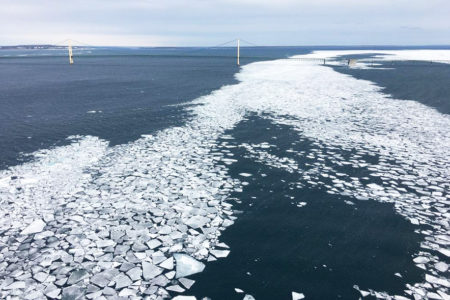Straits Cable Replacement Project
Project overview
Michigan’s Upper Peninsula and lower Michigan have been connected electrically for decades by two underwater 138,000-volt transmission lines, comprised of six cables. These connections are critical to electric reliability in the eastern U.P. and northern lower Michigan. ATC has removed the six underwater cables and re-established two new 138-kV circuits in the Straits, approximately four miles in length. The new circuits are comprised of two, three-phase submarine cables containing solid dielectric insulation.
Project need
In April 2018, ATC’s transmission lines were damaged when an anchor severed two of the cables and severely damaged a third. The three undamaged cables were reconfigured to form a single transmission line, allowing ATC to restore an electrical connection between the U.P. and lower Michigan. More information about the incident can be found at: atcllc.com/straitscables/.
With only one operating circuit in service across the Straits, there are risks to electric system reliability and maintenance in the region when other transmission lines are out of service – either planned or unplanned. Two new underwater transmission lines are needed to maintain adequate electric reliability and operating flexibility. Permits were required from the United States Army Corps of Engineers, Michigan’s Department of Environment, Great Lakes and Energy, and other local entities.
The cost of the project is under $105 million.
ATC’s construction process and environmental protection efforts:
ATC’s process and schedule for the cable removal and replacement:
| Project certified in MISO’s 2018 Transmission Expansion Plan: | Winter 2018 |
| Apply for permits from U.S. Army Corps of Engineers / Michigan's Dept. of Environment, Great Lakes & Energy: | Winter 2019-20 |
| Remove portions of submarine cables 5 & 6: | August - September 2020 |
| Anticipated approvals from ACOE/EGLE: | April 2021 |
| Remove existing submarine cables 1-6: | May - July 2021 |
| Install and energize first new submarine cable: | May - July 2021 |
| Install and energize second new submarine cable: | August - September 2021 |
| In service: | October 2021 |
| Project complete: | June 2022 |
| Mitigation complete: | Q3 2024 |
Which agency authorized ATC to move ahead with this project?
Following the 2018 incident that significantly damaged our submarine cables, ATC worked with the Midcontinent Independent System Operator to determine an appropriate solution for maintaining electric reliability in the Upper Peninsula. In its December 2018 Transmission Expansion Planning Report, MISO recommended the replacement of the two electric circuits in the Straits as soon as practical to ensure the continued reliable service to the Upper Peninsula. ATC has implemented a recovery plan that was authorized by MISO and we worked with the Michigan governor’s office along with other regulatory agencies to proceed with plans and permitting for this repair project.
How was ATC able to maintain an operable electric circuit following the 2018 cable damage?
Typically three cables comprise one circuit. Prior to April 2018, ATC operated a double circuit, 138-kV volt line, (six energized high-voltage cables) that ran across the lakebed of the Straits of Mackinac. Three of the cables were destroyed by an anchor strike in April 2018. Within weeks of the incident, the undamaged cables were reconfigured to create a single circuit. Visit the event response page to learn more.
What are the next steps for this project?
While installation of the cables is complete and primarily trenched, ATC has identified some locations that will require additional support and erosion mitigation by installing rock fill atop and underneath the spans. We are applying for permits with U.S. Army Corps of Engineers and Michigan’s Department of Environment, Great Lakes and Energy and we anticipate this work will take place in 2023.
How will ATC protect the new cables from a potential future impact?
Protecting the environment and shielding the cables from potential impact are a significant priority for ATC. MISO’s Board of Directors approved the project in its Midwest Transmission Expansion Plan in 2018 with the condition of ensuring these criteria. In partnership with our contractor, LS Cable Systems America, Inc., ATC’s project team deployed an underwater sled created a trench for the new cables. The trenched cables are protected within the lakebed from marine equipment. In some locations across the waterway, a protective rock barrier will also be installed atop and underneath the cables.
What is ATC doing to protect the waters with the new cables that will be installed?
Protecting the environment is paramount. Engineering advancements have evolved since the original cables were installed, and the new cables contain cross-linked polyethylene, a type of plastic, for insulation. They do not contain dielectric fluid and will not leak if damaged.
ATC applied for environmental permits to complete the cable removals from the U.S. Army Corps of Engineers and the Michigan Dept. of Environment, Great Lakes & Energy in early 2020. We received permits from both agencies for this work in April 2020 and received permission in fall 2020 to install the new cables in 2021.
How will ATC monitor the functionality of the new cables?
The two, new three-phase cables incorporate fiber optic strands within each of the high-voltage cables to allow for acoustic sensing and temperature monitoring.
Who will pay for the project?
Like all of ATC’s reliability-driven projects, the project cost is distributed amongst the utilities in ATC’s service area over the life of the infrastructure. Around 10 percent of a utility customer’s bill in ATC’s service area pays for transmission service, which includes transmission projects like this.

